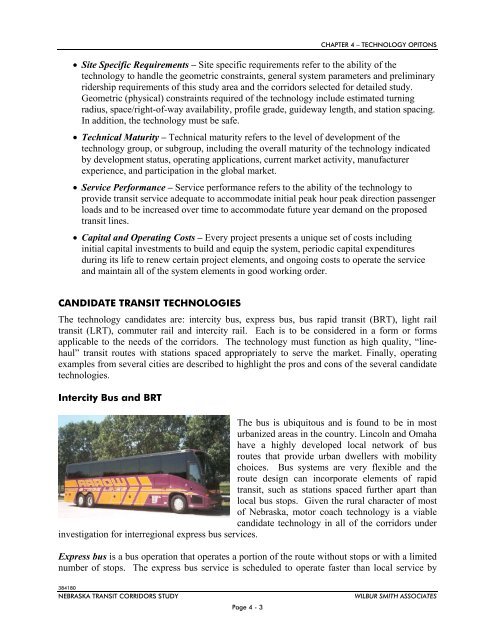NTRAC Final Study - Nebraska Department of Roads - State of ...
NTRAC Final Study - Nebraska Department of Roads - State of ...
NTRAC Final Study - Nebraska Department of Roads - State of ...
Create successful ePaper yourself
Turn your PDF publications into a flip-book with our unique Google optimized e-Paper software.
CHAPTER 4 – TECHNOLOGY OPITONS<br />
Site Specific Requirements – Site specific requirements refer to the ability <strong>of</strong> the<br />
technology to handle the geometric constraints, general system parameters and preliminary<br />
ridership requirements <strong>of</strong> this study area and the corridors selected for detailed study.<br />
Geometric (physical) constraints required <strong>of</strong> the technology include estimated turning<br />
radius, space/right-<strong>of</strong>-way availability, pr<strong>of</strong>ile grade, guideway length, and station spacing.<br />
In addition, the technology must be safe.<br />
Technical Maturity – Technical maturity refers to the level <strong>of</strong> development <strong>of</strong> the<br />
technology group, or subgroup, including the overall maturity <strong>of</strong> the technology indicated<br />
by development status, operating applications, current market activity, manufacturer<br />
experience, and participation in the global market.<br />
Service Performance – Service performance refers to the ability <strong>of</strong> the technology to<br />
provide transit service adequate to accommodate initial peak hour peak direction passenger<br />
loads and to be increased over time to accommodate future year demand on the proposed<br />
transit lines.<br />
Capital and Operating Costs – Every project presents a unique set <strong>of</strong> costs including<br />
initial capital investments to build and equip the system, periodic capital expenditures<br />
during its life to renew certain project elements, and ongoing costs to operate the service<br />
and maintain all <strong>of</strong> the system elements in good working order.<br />
CANDIDATE TRANSIT TECHNOLOGIES<br />
The technology candidates are: intercity bus, express bus, bus rapid transit (BRT), light rail<br />
transit (LRT), commuter rail and intercity rail. Each is to be considered in a form or forms<br />
applicable to the needs <strong>of</strong> the corridors. The technology must function as high quality, “linehaul”<br />
transit routes with stations spaced appropriately to serve the market. <strong>Final</strong>ly, operating<br />
examples from several cities are described to highlight the pros and cons <strong>of</strong> the several candidate<br />
technologies.<br />
Intercity Bus and BRT<br />
The bus is ubiquitous and is found to be in most<br />
urbanized areas in the country. Lincoln and Omaha<br />
have a highly developed local network <strong>of</strong> bus<br />
routes that provide urban dwellers with mobility<br />
choices. Bus systems are very flexible and the<br />
route design can incorporate elements <strong>of</strong> rapid<br />
transit, such as stations spaced further apart than<br />
local bus stops. Given the rural character <strong>of</strong> most<br />
<strong>of</strong> <strong>Nebraska</strong>, motor coach technology is a viable<br />
candidate technology in all <strong>of</strong> the corridors under<br />
investigation for interregional express bus services.<br />
Express bus is a bus operation that operates a portion <strong>of</strong> the route without stops or with a limited<br />
number <strong>of</strong> stops. The express bus service is scheduled to operate faster than local service by<br />
384180<br />
NEBRASKA TRANSIT CORRIDORS STUDY<br />
Page 4 - 3<br />
WILBUR SMITH ASSOCIATES

















